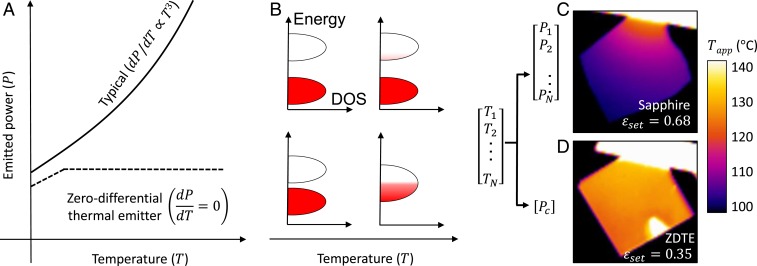Fig. 1.
Comparison between a typical thermal emitter and a zero-differential thermal emitter (ZDTE). (A and B) For a typical emitter, for example comprising a semiconductor or insulator (cartoon band diagram in B, Top), any change in emission from a temperature-dependent change in materials properties is dwarfed by the dependence in the Stefan–Boltzmann law. Conversely, a ZDTE decouples temperature and thermal radiation over some temperature range and thus can only be made using a material with a very strong temperature dependence. In our implementation, we use the hysteresis-free insulator-to-metal phase transition in samarium nickelate (SmNiO3) to achieve this behavior (B, Bottom). DOS, density of states. (C and D) LWIR images of samples mounted to hang off the edge of a heater stage, such that a temperature gradient is established from hot to cold. (C) A reference sample with a constant emissivity—in this case, a sapphire wafer—and (D) a ZDTE based on SmNiO3. The color bar encodes the apparent temperature, obtained by assuming a particular set emissivity, , which was chosen such that the sample region just below the heat stage appeared to be at 130 °C, which is the actual temperature at that point (see more discussion in Methods). For sapphire, there is a one-to-one relationship between temperature and thermally emitted power. Conversely, the ZDTE exhibits a constant emitted power over a range of temperatures, here ∼100 to 135 °C.

